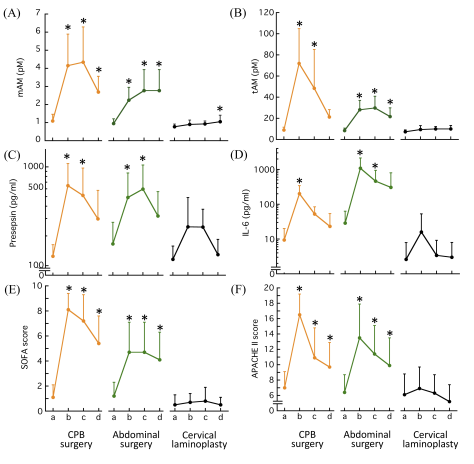-
Home
-
About JCTR
-
Gold Open Access
-
Issues
-
Editorial board
-
Author guidelines
-
Publication fees
-
Online first
-
Special issues
-
News
-
Publication ethics
-
Partners
-
Submit your manuscript
-
Submit your review report
-
Editorial Office
-

This work is licensed under a Creative Commons Attribution-NonCommercial 4.0 International License. ISSN print: 2382-6533 ISSN online: 2424-810X
Volume 7 issue 3
The usefulness of plasma levels of mature and total adrenomedullin as biomarkers indicating the magnitude of surgical stress responses: A single-center, prospective, observational study
Go Otao+, Toyoaki Maruta+,*, Tetsu Yonaha, Koji Igarashi, Sayaka Nagata, Kazuo Kitamura, Isao Tsuneyoshi
Otao et al. J Clin Transl Res 2021; 7(3):2
Published online: May 14, 2021
Abstract
Background and aim: Adrenomedullin (AM), a vasodilatory peptide, is known for its pleiotropic actions. AM levels are increased under inflammatory conditions such as sepsis and can be useful as a prognostic biomarker. However, there are only a few reports on the physiological actions of AM in the perioperative period. The aim of this single-center, prospective, observational study was to investigate the changes in the plasma levels of mature AM (mAM) and total AM (tAM) observed during the perioperative period. Additionally, we aimed to determine the association between each AM level and immune-inflammatory parameters to explore the usefulness of AM as a biomarker of the magnitude of surgical stress responses.
Methods: The levels of both mAM and tAM, in addition to the levels of presepsin, interleukin-6, procalcitonin, white blood cell, and C-reactive protein, were measured in blood samples obtained during the perioperative period. Other laboratory data, including sequential organ failure assessment (SOFA) and acute physiology and chronic health evaluation (APACHE) II scores, were obtained from individual clinical records. Correlations between each AM and clinical parameters were determined using Spearman's rank correlation. P-values < 0.05 were considered statistically significant.
Results: One-hundred and twenty-three perioperative patients scheduled for three types of surgical procedures, including cardiopulmonary bypass surgery, abdominal surgery, and cervical laminoplasty, were included in this study. There was a moderate to strong correlation between each AM and immune-inflammatory parameters, SOFA score, and APACHE II score, as related to surgical trauma. Specifically, the strongest correlation was observed between each AM and SOFA score.
Conclusions: These findings suggest that plasma AM levels may represent the most important inflammatory mediators that are evident in surgical stress responses.
Relevance for patients: Since the levels of both tAM and mAM show the same trend, mAM and tAM may be equally used as biomarkers for the evaluation of the physiological status of surgical patients.
Trial registration: This observational study was retrospectively registered with Japanese Clinical Trial Registry “UMIN-CTR” on March 19, 2018, and was given a trial ID number UMIN000031792.

DOI: http://dx.doi.org/10.18053/jctres.07.202103.002
Author affiliation
1 Department of Anesthesiology, Faculty of Medicine, University of Miyazaki, Miyazaki 889-1692, Japan
2 Research and Development Management, Bioscience Division, TOSOH Corporation, Ayase 252-1123, Japan
3 Circulatory and Body Fluid Regulation, Department of Internal Medicine, Faculty of Medicine, University of Miyazaki, Miyazaki 889-1692, Japan
+These authors contributed equally to this work
*Corresponding author
Toyoaki Maruta
Department of Anesthesiology, Faculty of Medicine, University of Miyazaki, Miyazaki 889-1692, Japan
E-mail: mmctm2@yahoo.co.jp
Handling editor:
Michal Heger
Department of Pharmaceutics, Utrecht University, the Netherlands
Department of Pharmaceutics, Jiaxing University Medical College, Zhejiang, China

